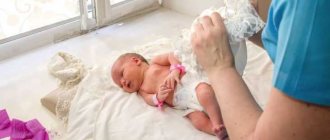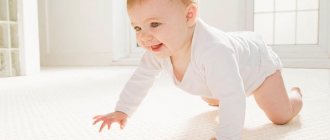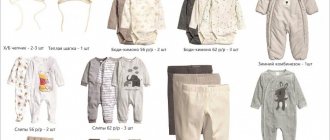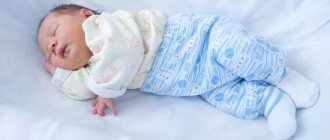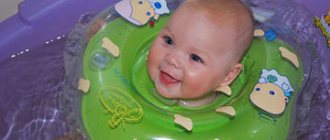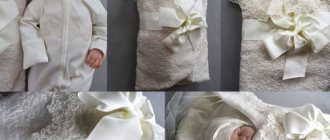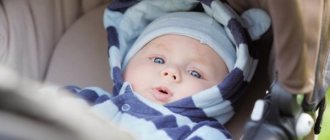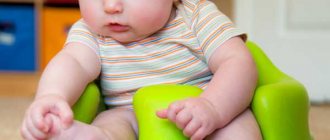All parents understand that overheating and subsequent hypothermia can cause the baby to catch a cold. Therefore, you need to dress your child in winter so that he does not freeze, but also does not sweat. We have prepared recommendations for you on clothing for different temperatures so that you can protect the fragile health of your baby and avoid many problems.
Common mistakes parents make
- Fully prepare your baby for going out and make him wait - he will not only start to be capricious, but will also have time to sweat while you put on outerwear, check for keys, a smartphone and the necessary little things. Coming out sweaty from a heated room into the cold, a child runs the risk of getting sick.
- Wearing a heavy, warm overall over light outerwear is fundamentally wrong. The child should be dressed evenly in layers. It is not fur, down or synthetic padding that warms, but the air that forms between the layers.
- Wrap the baby's face with a warm scarf. Warm breath will make the scarf damp. Children try to eliminate the discomfort and push it away with their palm. After some time, frost forms on the wool. This is not only unpleasant, but can also irritate delicate skin. It’s even worse if the child breathes for a long time, burying his nose in the scarf, and then manages to suddenly swallow the frosty air.
- Clothes don't fit. By dressing your baby in clothes “for growth”, you limit his freedom of movement - it will be uncomfortable for him to squat, bend, bend, or raise his arms. If shoes are too loose, he will constantly stumble and fall. Remember: the growth margin should not exceed 2 centimeters of foot length. The other extreme is things that the child has long outgrown. In cramped spaces, there are practically no layers of air—clothes provide little warmth.
A few simple truths
1. When going out, always dress yourself first, and then dress your child.
2. When going out to the store, use separate overalls (set) so that the child can take off the jacket. Take off your hat and scarf. The sight of children in stores dressed in overalls, hats and hoods causes panic.
3. Both cooling and overheating are equally harmful to a child’s health.
4. It is not multilayer clothing that keeps you warm, but the right clothing. It is not the insulation that warms, but the cavities between the fibers of the insulation (which is why many winter overalls are very light).
5. In its anatomical and physiological characteristics, a child’s body differs significantly from an adult’s body. It is unacceptable to compare your feelings with the feelings of a child: he is not the same as you. Your immunity, let's be honest, is impaired by improper eating, lack of sleep, and in some cases by smoking; all these factors directly affect frost resistance.
6. You can determine whether a child is cold by looking at the bridge of the nose, neck and skin above the feet and hands.
7. Rosy cheeks and nose are a sign of health and a great time, not freezing. The blood must flow to the face so that it does not freeze.
How to dress your child for a walk correctly
The child should not freeze, overheat or sweat.
Therefore, parents should regularly monitor the baby’s condition. The most common mistake made by young, inexperienced mothers is checking their nose and cheeks. To really tell if your baby is cold, feel the skin around the neck and chest. If the child turns pale, bursts into tears for no reason, and then becomes quiet or lethargic, he is most likely cold. This is also indicated by cold wrists and the bridge of the nose. If you are flushed, sweaty and restless, you are most likely overheated. Normal condition: rosy cheeks, moderately cool hands. It is important to remember the rule: depending on their mobility, calm children should be dressed warmer, and vice versa.
How to understand that a child is dressed incorrectly
You can understand that your child is cold or, conversely, overheated, by certain signs:
- Touch the baby's hands and, if possible, the legs - if the limbs are cold, it means the baby is cold. Put on extra socks or cover your child with a blanket if he is walking in a stroller.
- Other signs that the child is cold: whims for no apparent reason, lethargy, too pale face. In these cases, it is better to immediately take the boy or girl to a warm place.
- If you notice that the child is flushed and sweating, the baby is most likely overheated. Get home before your sweaty child starts to freeze.
- When a child is constantly thirsty, he is probably too hot. If possible, remove excess clothing and continue walking.
If you notice signs that your baby is overheated or too cold, the next time the weather conditions are the same, remove an extra layer of clothing or add another layer.
Clothes for newborns
- A little person from birth to 1 year
will need a warm down envelope. The Finnish brand Kerry produces very beautiful products with a soft velor lining. The hood and cuffs are lined with elastic bands. The palms are closed with soft cuffs. - For children from 3 to 6 months,
envelopes with sleeves and a hood are produced, which give the baby greater freedom of movement to explore the world around him. - Newborns from 6 months to 1 year
will need warm boots and mittens. Pants can be replaced with tights. - Rule of 3 layers: The first layer includes diaper, romper, vest, cap. The second is pants with a blouse. The third is overalls, hat, scarf. Next, we wrap the baby in an envelope.
Children's cosmetics against frost
The use of frost creams is not necessary. A child lying in a closed stroller does not need frost cream, even if you periodically pull him out. You can use the cream if the child has sensitive skin, and the cheeks very quickly become purple and chapped. You cannot use regular baby cream - it contains water, it will freeze in the cold. Only rich nourishing cream. Be sure to look for age indications to ensure the cream is fragrance-free. For a child with diathesis (dry cheeks, rash), walks in the cold are extremely beneficial; in this case, there is no need for cream, but only if the allergy is definitely not to the cold itself.
Anti-frost creams are produced by the following companies: Nasha Mama, Bübchen, JOHNSON`S BABY, Avent.
Clothes for children from 1 to 3 years old
At this age, children begin to move actively, so clothes should be light and comfortable. The ideal option is a jumpsuit. Sleeves and legs should fit snugly around the wrists. The item must be comfortable to put on. It is welcome to have a long zipper, as well as Velcro, with which you can adjust the volume at any time. It is very good if the overalls have a detachable hood or a high collar that will protect the child’s neck from wind and cold. From the age of 3 you can switch to a separate set - a jacket and trousers.
Rule #1. Forget about cotton underwear
We were taught from childhood: natural materials are our everything. But this is in the summer. You shouldn't wear cotton at any other time of the year. Especially if it's hot. And that's why.
When your child sweats, the cotton jersey absorbs moisture. Cotton does not dry, so a wet tank top will keep your body cool. Therefore, in winter, a child, even if dressed in a very warm down jacket, can freeze in 10-15 minutes...
The body and clothes should be dry in winter. Always. Therefore, if possible, it is better to purchase special children's thermal underwear. It wicks away body moisture and maintains body temperature.
Important: thermal underwear is worn on a naked body. There is no need to wear any T-shirts or T-shirts. Otherwise, the meaning of thermal underwear is lost.
Recommendations for children over 3 years old
- We follow the principle of multi-layering.
The number of layers depends on the degree of frost outside and the child’s temperament: active children move more actively and freeze less.
To prevent your baby from overheating and sweating, remember the rule of 3 layers. 1. Underwear.
Up to 5 degrees below zero - we put cotton and viscose on the child.
At lower temperatures - wool with acrylic. The Kerry brand, which has earned the respect of parents around the world, produces children's thermal underwear with cutting-edge blended fibers that ensure ideal air and moisture exchange. The company's technologists are well versed in materials and know that pure cotton and wool absorb sweat, but do not remove it from the body, creating a greenhouse effect. 2. Intermediate layer
- warming: fleece suit, woolen or acrylic overalls.
This layer performs the function of storing heat. 3. Warm outerwear.
Starting from 3 years old, it is more convenient for children to play in separate sets. The Kerry brand produces warm winter clothes for children with breathable, windproof and waterproof properties: the filling is branded thermal insulation Isosoft, making things almost weightless. Many products are available with detachable hoods, trimmed with natural and faux fur. - A cap
. Choose ones with ears and ties. Children actively turn their heads, so an ordinary hat will constantly slide down. The ideal option is a helmet hat that protects not only the baby’s head, but also the neck from wind and cold. The Kerry brand produces warm woolen helmets with a cotton lining; for older children, hats with ear ties and a wide elastic band along the entire contour. - Mittens and mittens
must be made of breathable, waterproof membrane fabric. Your palms won't sweat in these. In addition, the child will be able to sculpt snowmen and play with ice icicles as much as he wants without the risk of getting his hands wet. - Choose comfortable shoes
. The texture should be soft and flexible so that the foot bends freely and maintains mobility during any type of activity. For severe frosts, products made from natural sheepskin, wool, felt, polyester, and holofiber are good. Up to 5 degrees below zero, high boots made of membrane fabric with thermoregulating properties are suitable.
–15/–25
In severe frost, we leave the same clothes, but limit the walking time: a maximum of an hour in calm weather and up to 30 minutes in windy weather. Babies under 1 year old should not be taken outside when the temperature drops below -15 degrees.
Follow our recommendations, but do not forget that all children are different, so you need to pay attention to the individual characteristics of the child.
Benefits of Kerry children's winter clothing
- The products meet European and international standards.
- Finnish quality is adapted to harsh Russian winters.
- New generation insulation materials are used in production to prevent the baby from overheating and sweating.
- Clothes do not restrict freedom of movement, allowing children to move actively.
- Membrane fabrics have breathable, water-repellent and windproof properties.
- The items have zippers and Velcro to regulate volume, as well as reflective elements to increase safety in the evening.
- Fashionable bright design that children and parents like.
- The products are easy to wash and retain an aesthetically attractive appearance for a long time.
- Affordable price with high quality.
Kerry products are certified in Russia. We purchase goods from Finland directly. We have professional consultants who will help you make your choice. Every purchase comes with a manufacturer's warranty. We deliver orders anywhere in Russia. If for some reason the item is not suitable, we will return the money without any questions asked.
Walking during and after illness
How to dress for walks if your child is sick: under no circumstances over-dress! Dress exactly the same as usual. After all, he was usually warm? – and if there is a sore, it will also be warm, but the child should absolutely not sweat.
Quotes from Dr. Komarovsky’s new book (information taken from the website komarovskiy.net).
With acute respiratory infections (viral or bacterial), a sick child can pose an epidemiological danger to others. Hence two particularly important questions: are we contagious or not, and if so, do we come into contact with other children (people) while walking or not. It is clear that the forester’s son Petya can walk whenever he wants, but the engineer’s daughter Natasha, who has many friends in the yard, is temporarily exempt from walks, or walks early in the morning, late in the evening, or is not allowed near the sandbox. But let's return to the child's condition. The paradox is that almost no question can be answered unambiguously. Take, for example, the statement: “you can’t walk when your body temperature is high.” It would seem: what’s there to argue about? It is forbidden. But if it’s summer outside, +40 °C in the house, and +25 °C in the shade under an oak tree - where will it be better? However, when the ambient temperature is below freezing, it makes sense to walk if the body temperature is normal.
It should be noted that in the vast majority of situations, going out is not an end in itself, not a whim of a child, not “entertainment” for a mother, and not a dubious recommendation from a doctor. Walking is the cure! Treatment, primarily at the recovery stage, can significantly enhance recovery. The statement that walking speeds up recovery does not require any special comment. Fresh air - what else is needed to tidy up the respiratory tract! But there is one point that requires detailed clarification. The fact is that when inhaling cool (cold) air, the blood supply to the bronchial mucosa is significantly increased, the work of the secretory glands is activated, and sputum is moistened. If during a walk a child develops (or intensifies) a wet cough, which was not present in the house (or was only slightly pronounced), then this is a very (!!!) positive sign, indicating that the child has a real chance of coughing up mucus, accumulated in the respiratory tract. For many diseases accompanied by increased formation of mucus in the respiratory tract (whooping cough, croup, obstructive bronchitis), clean, cool air is a more important factor in treatment than all medications combined. But something else is even more important: cool air is an effective way to provide emergency assistance for any health problems characterized by the complaint of “difficulty breathing.”
